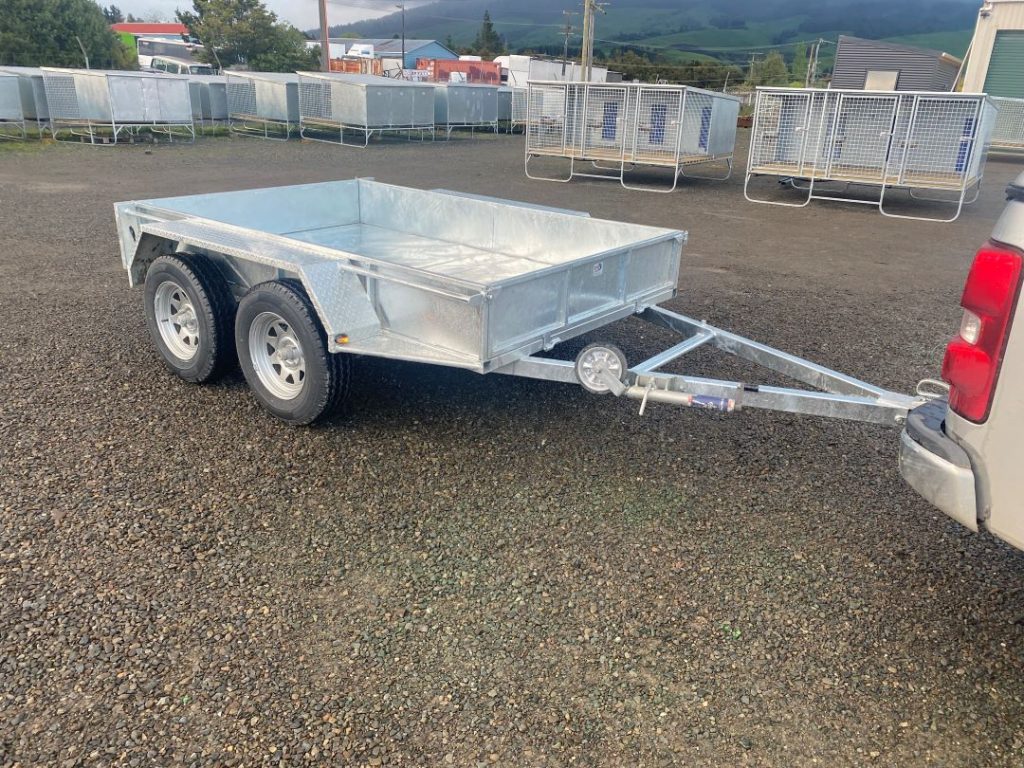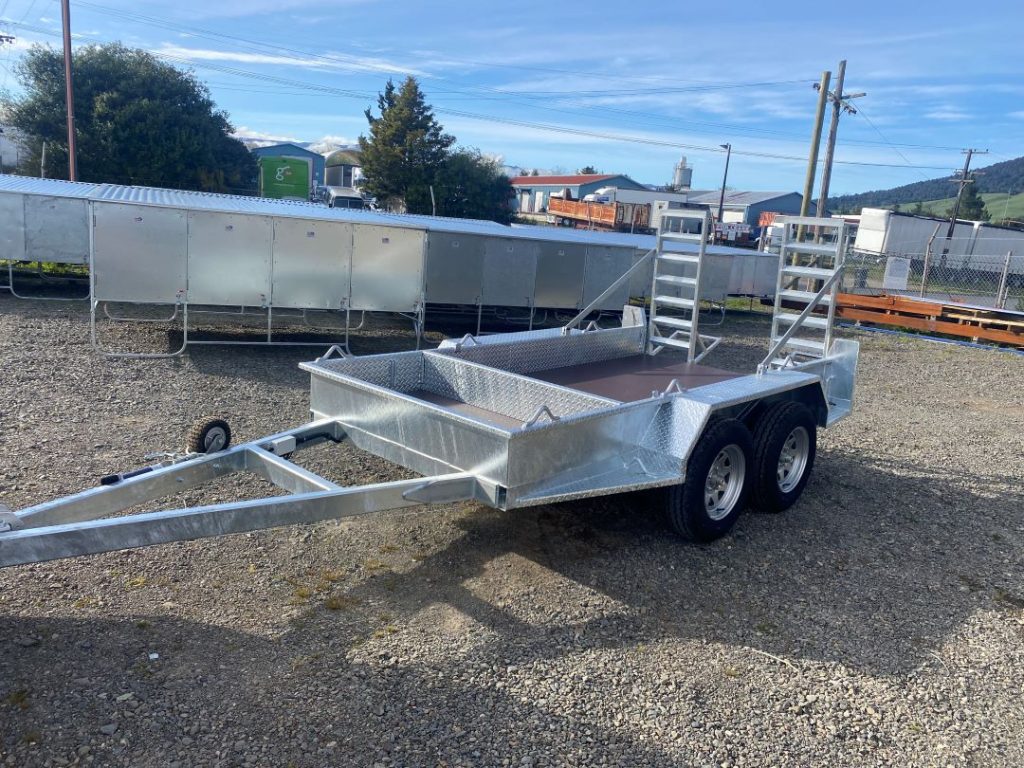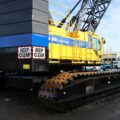Whether you need a trailer for work, recreation, or household use, which type of trailer is better for you? Should you purchase a tandem trailer, or is a single axle all you need?
Trailer Manufacturers have a range of options to suit everyone’s needs. Let’s look at the two main types of trailer together with their advantages and disadvantages.
What is a tandem axle trailer?
A tandem axle trailer is a type of trailer that has two axles, one behind the other.

This configuration is typically used in trailers that are longer and heavier, such as horse trailers, boat trailers, and RV trailers. The tandem axle trailer provides better stability and handling than a single axle trailer, but it is also more expensive and difficult to maneuver.
Trailer manufacturers utilize this design in order to distribute the weight of the load more evenly, which can be beneficial when hauling heavy loads. In addition, tandem axle trailers can also be equipped with brakes on both axles, which can provide additional stopping power.
Tandem axle trailers can be either open or enclosed, and they can be equipped with various features to make them more functional for different purposes.
There are many different types of tandem axle trailers on the market today. Some are designed for hauling heavy loads, while others are more lightweight and designed for easy towing. There are also a variety of optional features that can be added to a tandem axle trailer to make it more versatile and functional.
What is a single axle trailer?
A single axle trailer is a vehicle that is towed behind a car or truck and has only one axle. This type of trailer is typically used for hauling smaller loads, such as household rubbish or furniture.

Single axle trailers are generally easier to maneuver than larger trailers, and they can be easier to park in tight spaces.
They are also typically less expensive.
The difference between tandem and single axle trailers
Apart from the number of axles, tandem trailers are generally wider and can carry more weight than single axle trailers. However, this also means that tandem trailers are more difficult to maneuver, especially in tight spaces.
Another key difference is in the suspension. Tandem trailers have independent suspension, which means each axle can move up and down independently. This helps to distribute weight more evenly and makes for a smoother ride.
Finally, tandem trailers are typically more expensive than single axle trailers. This is because they are larger and have more complex suspension. However, they can be worth the extra cost if you need to haul a lot of weight or need a smoother ride. The advantage of tandem axle trailers
Despite these differences, trailer manufacturers create tandem and single axle trailers to suit a variety of purposes. Tandem trailers are often used for hauling large loads, while single axle trailers are more commonly used for lighter loads. Both types of trailers can be used for either personal or commercial purposes.
Overall, the decision of whether to use a tandem or single axle trailer depends on the specific needs of the user. If weight capacity is the most important factor, then a tandem trailer is the better option. If maneuverability is more important, then a single axle trailer may be the better choice.
The advantage of tandem axle trailers
Tandem axle trailers have many advantages over single axle trailers. They are able to carry more weight, which is important for hauling large loads. They are also more stable on the road, which makes them safer to tow. Additionally, tandem axle trailers can be outfitted with features that single axle trailers cannot, such as air brakes and electric winches.
The increased weight capacity of tandem axle trailers is their biggest advantage. They can typically carry up to twice the weight of a single axle trailer. This is ideal for hauling large items, such as boats and RVs.
Tandem axle trailers are also more stable than single axle trailers. This is because the weight is evenly distributed between the two axles, rather than being concentrated on one axle. This makes them less likely to tip over when taking sharp turns or going over bumps in the road.
Additionally, trailer manufacturers can add features to tandem trailers that single axle trailers cannot as easily have. Some common optional features for tandem axle trailers include:
Enclosed storage: Enclosed storage areas can be used to store tools, equipment, or other items that need to be kept safe and out of the weather.
Electric brakes: This can be a great addition for those who plan to use their trailer on hills or in other situations where extra braking power may be needed. Electric brakes are also often required by law in some places.
Hitch adapters: Hitch adapters can be used to tow a variety of different types of trailers, making a tandem axle trailer even more versatile.
Ramps: Ramps can be very helpful for loading and unloading heavy equipment or vehicles from the trailer. Ramps can also be used to provide access for wheelchair users or those with limited mobility.
Cage: Cages are particularly useful when using the tandem trailer to carry animals, or equipment. The cage prevents the load from falling off the trailer.

The disadvantage of tandem axle trailers
There are a few disadvantages to tandem axle trailers. The main disadvantage is that they are more expensive than single axle trailers.
Another disadvantage of tandem axle trailers is their increased weight. Tandem axle trailers can weigh up to 30% more than a single axle trailer of the same size and capacity. This increase in weight can make them more difficult to tow, and can also decrease fuel efficiency.
Tandem axle trailers also tend to be more difficult to manoeuvre than single axle trailers. This is due to their increased length and weight. When making turns, tandem axle trailers have a tendency to swing out wider than single axle trailers, making it necessary to take wider turns.
Finally, tandem axle trailers can be more difficult to service than single axle trailers. This is because they have twice as many tires and twice as many brakes, which can make it more time consuming and expensive to perform routine maintenance.
If you have concerns about any of these disadvantages, discuss your concern with your local trailer manufacturers and they may be able to adjust the design to suit.
The advantage of single axle trailers
There are many advantages to single axle trailers. Single axle trailersare perfect for home maintenance, landscaping, and moving furniture.
Perhaps the most significant advantage is its simplicity. Single axle trailers are less complex than their multi-axle counterparts, and as such, are easier to maintain and repair.
They are also typically lighter and more manoeuverable than multi-axle trailers, making them ideal for use in tight spaces or on rough terrain.
Another advantage of single axle trailers is that they are generally less expensive than multi-axle trailers. This is due in part to their simpler design, but also because trailer manufacturers typically require less material and time to construct them. This can be a significant saving for those who need to purchase multiple trailers for their business.
When discussing cost, an often overlooked factor is fuel efficiency. Single axle trailers are more fuel efficient than their dual axle counterparts for several reasons.
First, single axle trailers have less wind resistance. This is because there is only one axle to create drag as opposed to two. This difference may seem small, but it can add up over time, especially if you are doing a lot of highway driving.
Second, single axle trailers are lighter weight. This also contributes to less drag and therefore better fuel efficiency. In addition, the lighter weight makes it easier on your tow vehicle, which can also save on fuel.
Single axle trailers also have a lower profile, which makes them less likely to be damaged in windy conditions.
Single axle trailers typically have a shorter turning radius, which can be helpful when negotiating tight spaces.
Finally, single axle trailers have the advantage of being easier to store and transport than multi-axle trailers. This is because they are typically smaller and require less space to park or store. They are also easier to load onto a truck or trailer for transport.
The disadvantage of single axle trailers
While single axle trailers are more affordable and easier to manoeuvre than tandem axle trailers, they have several disadvantages.
One major disadvantage is that they are not as stable as tandem axle trailers. This can be a problem when transporting heavy loads or in windy conditions.
Another disadvantage is that single axle trailers have a lower capacity than tandem axle trailers. This means that you may have to make more trips to transport the same amount of material.
Finally, single axle trailers are more likely to experience tire problems because the weight of the trailer is concentrated on one axle. This can lead to premature wear and tear on the tires, as well as increased likelihood of a blowout.
Conclusion
There are many factors to consider when deciding between tandem and single axle trailers.
One of the most important factors is the weight of the load you will be carrying. If you are carrying a heavy load, you will need a tandem axle trailer. Tandem axle trailers are also better for hauling large loads over long distances.
If you are only carrying a light load, a single axle trailer will be sufficient. Single axle trailers are also less expensive than tandem axle trailers.
Another factor to consider is the type of terrain you will be traveling on. If you will be traveling on rough terrain, a tandem axle trailer will be better able to handle the bumps and potholes. If you are only traveling on paved roads, a single axle trailer will be just fine.
You should also consider the length of your trailer. Tandem axle trailers are available in both long and short lengths. If you need a long trailer, you will need a tandem axle trailer.
Perhaps the main factor is the cost. A tandem trailer will always cost more than a single axle trailer. The question becomes, which will be cheaper in the long run?
Ultimately, the decision between tandem and single axle trailers comes down to personal preference and the specific needs of your trip. Consider all of the factors before making your decision to ensure you choose the right trailer for your needs.











